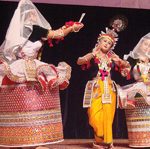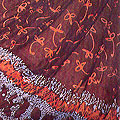
Endangered/ Red List, Natural Dyes, Pigments, Colours, Textiles, Weaving, Spinning, Khadi, Theatre, Performance Crafts
Dance Costumes of Manipur
Manipuri dance form is a traditional dance form of Manipur that originated during the reign of King Bhagya Chandra (1763-1798). The costume of the dance was also designed by the King himself. It is said that the king had a dream that helped him develop the costume of Manipuri dance.
The costumes of Manipur are bright in colours and beautifully ornated with embroidery. The Manipuri dance has its root in legend and mythology. The dance is based on Krishna leela and Raas leela themes. Where the Radha wears a Green coloured skirt and the other gopis wear red coloured skirts as a distinguishing mark. The male attire is always in orange and saffron colour. So the Krishna wears saffron coloured dress.
Potlei is the name given to the Raas costume of Sri Radhika and the Gopis, The main components of the Manipuri dance costumes are as follows:
Head Accessories
- Koknaam: Gauze overhead, embossed with silver Zari.
- Leitreng: Golden ring round the head.
- Koktombi: Cap covering the head.
- Chura: Made of peacock feathers, wired on top of head.
- Meikhumbi: A transparent and thin veil thrown over the head.
Female Upper Garment
- Choli: A tight fitted blouse worn on top of the skirt. It is brightly coloured to match with the skirt.
Female Lower Garment
- Kumin: An Embroidered brightly colored silk or satin skirt.
- Pasuan: A short flair of silver gauze over the Kumin.
- Khangoi: Small rectangular belt over the Pasuan.
- khaon: Rectangular embroidered piece with belt.
- Thabret: A griddle round the waist.
Male Lower Garment
- Feichom: Dhoti; a saffron dress; Male attire.
Foot Accessory.
- Ghungur: Ornament for the foot.
Gallery
YOUR VIEWS
PRACTITIONERS: INDIA
Access 70,000+ practitioners in 2500+ crafts across India.
BIBLIOGRAPHY
10,000+ listings on arts, crafts, design, heritage, culture etc.
GLOSSARY
Rich and often unfamiliar vocabulary of crafts and textiles.
SHOP at India InCH
Needs to be written.





